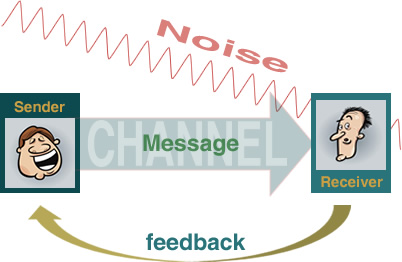Steps in the Communication Process
The Communication Process can be broken down into several commonly accepted steps that are comprised of the following components:
The Sender – This is the individual or group who is initiating the message. This message can be verbal or non-verbal, can be ongoing or a one-off, can be conscious or unconscious. The Sender can also be referred to as the Communicator.
The Receiver – There must be a message sent if there is one to be received. The Receiver – sometimes known as the Interpreter – is the individual or group to whom the message is sent. Sometimes, a message received was one that was not necessarily intended to be.
The Message – This is the particular content that is sent and received. The message is coded by the users in a process that we will describe shortly.
The Channel – (or Medium) is the means by which the message is sent. Some common channels are: spoken voice/telephone/radio/television, written word, computer,
The Context – This is the setting or environment in which the message is conveyed
Feedback – This is the response by the Receiver as to the success of the communication

The Communication Model
The diagram above, also known as the Communication Model is quite simple, yet thorough, in its representation of the communication process. It covers all types of communication. For our purposes today, we shall focus on interpersonal communication.
All communication begins with the sender and ends with the receiver. There needs to be a receiver for the message to be successfully conveyed, but that does not guarantee success. The sender is responsible for successful conveyance, but that does not mean that he or she has absolute control over the process. Clarity of message is obviously important, but not always easy to know beforehand. The sender’s personality, beliefs, cultural, education all influence the message and it is important for the sender to be aware of this as he or she is encoding the message. Simply put, encoding is translating information into symbols that represent the ideas or concepts of the message that needs sending. These symbols are usually words in written or spoken form. To ensure successful communication, the sender should know as much about his or her audience – the receiver – as possible in order to focus and support the encoding process. A lesson by an instructor will be encoded differently for a university classroom compared to an elementary classroom.
In addition to this awareness of self and encoding, the sender must choose the proper channel to convey the message. Using the wrong channel may result in miscommunication. A channel can take many forms and can change depending upon the type of message being sent and the desired outcomes of the message. If one of those desired outcomes is immediate feedback, a hand-written, postal-delivered letter would probably not be the best choice. Written and oral channels can take on a variety of forms. Telephones and computers, email and texting are everywhere today; however, social protocols need to be considered. There are times when an email or a text are not appropriate or when a face-to-face communication is preferred over a phone call.
Like the sender, receivers are influenced by internal factors: their personality, their receptivity to the message or their relationship to the sender, their current feelings, mood, or state of mind can affect a message. Their education, culture and prior knowledge can also alter successful message reception.
Once the message moves through the channel, the receiver then decodes it. The receiver interprets the sent symbols and attempts to assign some meaning to them and to the message in general. The receiver uses his or her own experience and the context of the message to interpret its meaning.
Feedback is the return message from receiver to sender – a response to the message that can take any number of forms. Even a non-response can be interpreted as feedback. It is the feedback that enables the sender to know whether the message was received successfully or not. Therefore it is essential to the communication process.
This process, though very common, is fraught with potential breakdown at every turn. Spoken or written language is inherently easy to misinterpret. Even a certain look or facial expression can be misinterpreted and cause breakdowns. A misplaced comma, or a thoughtful pause in response to a question can be mistaken for another intention. All of these possibilities (and many more!) are considered “noise,” which is anything that can interfere with any part of the process of communication. Noise can be literally “noise” that comes from some outside source. It can also come internally from a sender’s or receiver’s thoughts or presuppositions. Effective Communication is when the sent message was successfully received and the receiver provides the sender with desirable feedback.
This is a rather laborious explanation of the Communication Process; a process that can take quite some time to explain, and can oftentimes take a split second to occur. In our next article, we’ll discuss some of the things that can get in the way of the Communication Process.










what is the importance of context in the communication process
#confused